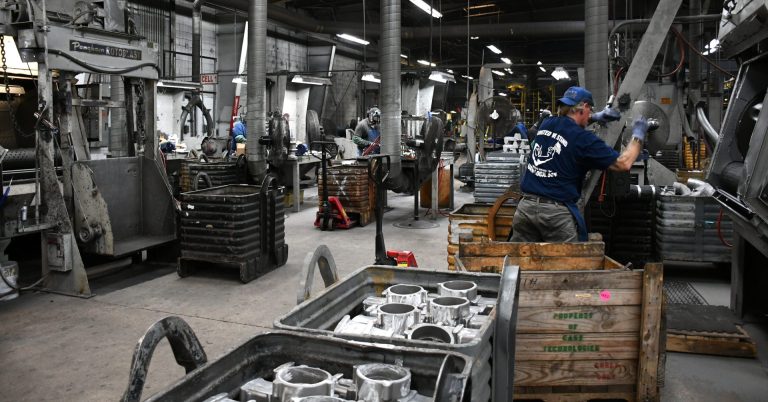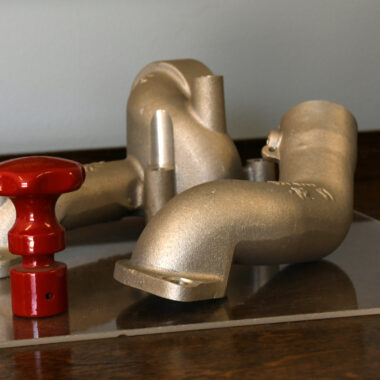Casting Aluminum Proficiency: Unleash Your Imaginative Prospective
Casting Aluminum Proficiency: Unleash Your Imaginative Prospective
Blog Article
Opening the Possible of Aluminum Spreading: A Comprehensive Summary
Aluminum casting stands as a foundation in the realm of metalworking, offering a wide range of advantages and applications throughout different industries. From its historic significance to the modern-day developments in casting methods, light weight aluminum has constantly proven itself as a versatile and beneficial material. As we navigate via the landscape of aluminum spreading processes and explore the intricacies of quality assurance procedures, a thorough introduction of opening the real potential of this metal arises. The opportunities seem endless, appealing insights that can transform the method we regard and use light weight aluminum in production (casting aluminum).

Background of Light Weight Aluminum Spreading
Aluminum spreading has an abundant historical history that goes back to ancient people, showcasing the sustaining significance of this metallurgical procedure in different markets. When ancient human beings like the Egyptians and the Sumerians utilized rudimentary approaches to cast small items, the origins of aluminum spreading can be traced to about 5,000 B.C.. Nonetheless, it was not until the 19th century that light weight aluminum spreading saw substantial improvements with the discovery of the Hall-Héroult process for drawing out aluminum from its ore, making it a lot more available for casting objectives.
The flexibility of aluminum casting allowed for complicated forms and complex layouts to be created with accuracy, further sustaining its adoption throughout different sectors. Today, aluminum spreading continues to be a keystone in the production of a wide array of items, highlighting its long-lasting heritage and importance in contemporary production processes.
Applications and advantages
With its exceptional strength-to-weight proportion and outstanding thermal conductivity, light weight aluminum spreading uses a myriad of advantages and varied applications throughout various markets. Among the key advantages of light weight aluminum casting is its lightweight nature, making it an optimal option for markets where weight decrease is essential, such as automotive and aerospace. casting aluminum. Furthermore, light weight aluminum spreading gives outstanding rust resistance, making certain durability and durability in harsh settings. Its high thermal conductivity likewise makes it a favored choice for applications requiring warm dissipation, like in digital elements and warmth exchangers.
In terms of applications, light weight aluminum spreading is extensively utilized in the automotive market for components like engine blocks, cylinder heads, and wheels because of its strength and lightweight residential or commercial properties. The building sector gain from aluminum casting in the production of structural parts and ornamental aspects. Moreover, the flexibility of light weight aluminum spreading includes customer electronic devices, where it is used in the manufacturing of housings and heat sinks. On the whole, the advantages of aluminum spreading incorporated with its varied applications make it a crucial product in numerous industrial sectors.
Kinds Of Aluminum Spreading Procedures

Among the numerous methods employed in industrial setups, light weight aluminum casting procedures encompass a series of techniques fit to various applications and requirements. One of the most typical techniques is sand casting, where a mold is developed by condensing sand around a pattern of the wanted part. This process is cost-efficient and flexible, making it popular for both little and large manufacturing. One more widely made use of technique is die casting, which involves compeling liquified aluminum right into a mold cavity under high pressure. Die spreading enables high precision and repeatability, making it perfect for generating complex shapes with thin wall surfaces. Investment casting, additionally called lost-wax casting, is favored for its ability to produce intricate and thorough get rid of a smooth surface area coating. Permanent mold and mildew spreading involves using multiple-use metal mold and mildews to develop top quality and constant light weight aluminum components. Each of these aluminum casting processes offers one-of-a-kind benefits, providing to a large range of commercial needs.
Developments in Aluminum Casting Techniques
Recent advancements in light weight aluminum spreading strategies have transformed the production market, offering improved efficiency and accuracy in the manufacturing of complex parts. One remarkable innovation is the development of 3D see this website sand printing innovation, which allows the creation of intricate sand molds with very little manual work. This method permits greater design versatility and faster production cycles, making it optimal for prototyping and small batch manufacturing.
Furthermore, using innovative simulation software program has significantly enhanced the spreading process by enabling designers to optimize mold and mildew layouts and predict potential flaws before production begins (casting aluminum). This leads to boosted item quality and reduced material waste
Additionally, the adoption of vacuum-assisted light weight aluminum spreading has boosted the total quality of spreadings by minimizing porosity and guaranteeing an extra uniform circulation read of molten metal. This technique is particularly valuable for elements that call for high architectural stability and premium surface finish.
Top Quality Control in Aluminum Casting
The improvements in light weight aluminum spreading techniques have not only boosted effectiveness and precision but have also highlighted the important significance of top quality control in ensuring the reliability and performance of cast elements. Quality assurance in aluminum spreading includes a systematic technique to keep track of and evaluate the production process, identifying any discrepancies from set criteria that might affect the end product.
One vital facet of quality assurance is the use of sophisticated innovations such as non-destructive testing methods like X-ray and ultrasound to spot inner issues without endangering the honesty of the actors components. In addition, implementing strenuous examination protocols at various phases of manufacturing assists in identifying and correcting concerns immediately, making certain that only elements fulfilling the defined standards are released for use.
Furthermore, quality control prolongs past the manufacturing procedure to include post-casting procedures like heat therapy and surface area finishing, ensuring that the end products satisfy the preferred specs. By focusing on quality assurance measures, suppliers can enhance item uniformity, toughness, and total customer reference satisfaction in the realm of aluminum casting.
Verdict
Various types of casting procedures and ingenious techniques have been established to boost the performance and quality of aluminum casting. Overall, aluminum spreading proceeds to be a valuable production procedure with wonderful prospective for more innovations in the future.
As we navigate with the landscape of light weight aluminum casting processes and dig right into the ins and outs of quality control steps, an extensive summary of unlocking the real potential of this steel emerges. It was not until the 19th century that aluminum spreading saw considerable innovations with the discovery of the Hall-Héroult process for removing light weight aluminum from its ore, making it more easily accessible for casting purposes.
Among the various techniques used in commercial settings, aluminum casting processes include a variety of techniques suited to different applications and needs. Investment spreading, additionally recognized as lost-wax casting, is favored for its ability to generate in-depth and detailed components with a smooth surface coating. Different types of casting processes and ingenious strategies have been established to improve the performance and high quality of light weight aluminum casting.
Report this page